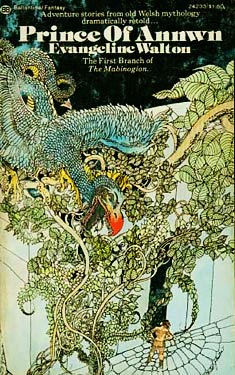Evangeline Walton
Completed 3/6/2022, Reviewed 3/6/2022
3 stars
This book is the beginning of a tetralogy written by an American unassuming lover of fantasy and especially the Welsh collection of mythological tales called the Mabinogion. Walton wrote four books retelling the Mabinogion, but only the last was published at the time and it didn’t fare well. However, when fantasy grew in popularity in the 70s, that book was rediscovered. A publisher searched for Walton and found her in seclusion in Arizona. They found out she had three other books written and all four were published. She gained fame for the work, being called by many one of the greatest fantasies ever. This book was nominated for the 1975 Mythopoeic Award.
This book is divided into two parts. The first introduces us to Pwyll, the Prince of Dyved. Dyved is in pre-Christian Wales at a time when the goddess-centered beliefs of the Old Tribes are being muscled out by the male god-centered beliefs of the New Tribes. Pwyll is of the New Tribes, but doesn’t necessarily hold the old beliefs in complete contempt as his Druids do. While out on a hunt, Pwyll meets Arawn, King of the Underworld. Arawn gives him the quest of killing the one being he himself cannot kill. He exchanges places with Pwyll for a year, though to Pwyll it seems only a few days that he is in the Other world. While there, he meets his future love interest, Rhiannon, a goddess. In the second part, Pwyll is being blamed for the bad weather, crop failures, and general despair of Dyved because he does not have a queen. Rather than abdicate or succumb to assassination by the Druids, he goes in search of a mystical answer. There he meets a woman who turns out to be Rhiannon, though at first, he doesn’t recognize her as the goddess; she is just a magical being from the Other world. On his wedding day, he is tricked into giving her to someone else and must somehow find a way to win her back.
I wasn’t overwhelmed by this book. I’m always up for mythological retellings, but found Walton’s storytelling style to be dry. The prose is very plain. Walton said that her goal was to flesh out the basic myths, but it felt like she didn’t go far enough with that. Apparently, she sticks very well to the original story, which it is believed was first written in the 11th century and translated in the last century. There just didn’t seem to be much life in the telling.
In both stories, Pwyll is the main character. We do get a sense of who he is, but it’s not deep. We just know that he is an honest man with integrity and a fighting spirit. Despite being of the New Tribes, he is less dismissive of women than the Druids and many of his peers. I liked him but never empathized with him. We don’t get much development of the other characters. We know that Arawn is Death and is not necessarily a trickster. And we know that Rhiannon loves Pwyll. But that’s about it.
I give this book three out of five stars. I’ll continue reading through the series since the third book won the Mythopoeic Award and it is the last of the award winners I have yet to read. I may even read the fourth book, more to complete the series because it is considered a classic. But I’m hoping that the writing gets better, or I somehow become more attached to the characters.

No comments:
Post a Comment